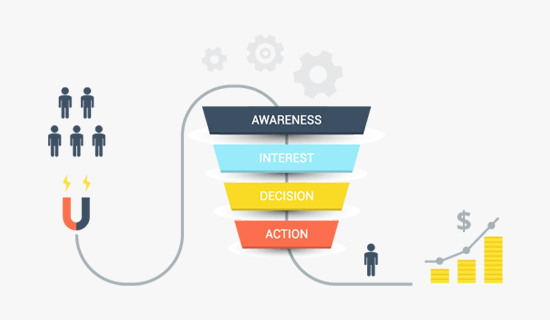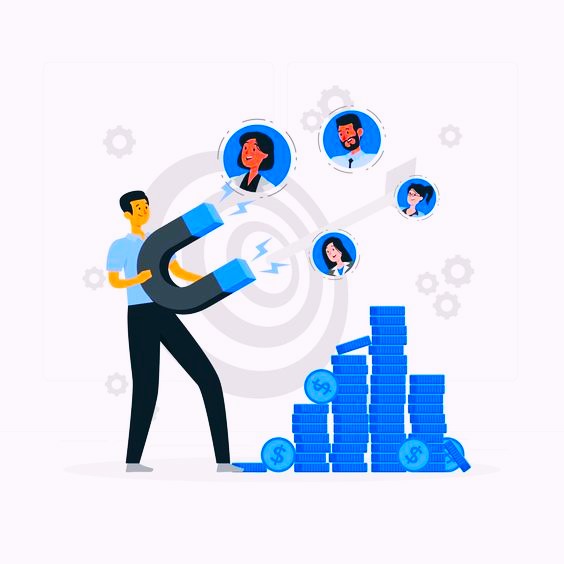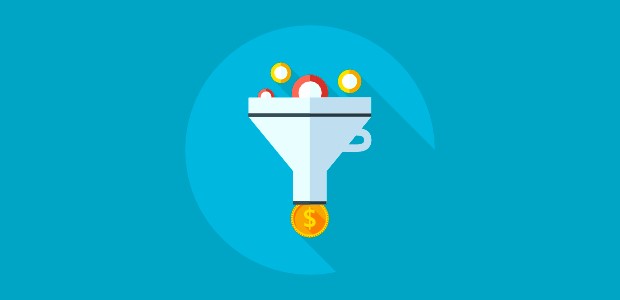I. Introduction
In the ever-evolving landscape of business, where digital realms hold the key to success, navigating the path to customer acquisition and retention requires more than just a strategy—it demands a roadmap that guides potential clients seamlessly from curiosity to conversion. Enter the realm of sales funnels, a dynamic force shaping how businesses engage with their audience, decode their needs, and deliver solutions that matter.
A. The Crucial Role of Sales Funnels
In the chaotic dance of the digital marketplace, the importance of a well-crafted sales funnel cannot be overstated. It is not a mere concept; it’s the heartbeat of sustainable business growth. Picture this: a strategically designed pathway that not only attracts potential clients but guides them through an immersive journey, addressing their concerns, building trust, and ultimately leading them to a decision. It’s not about bombarding prospects with pitches but creating an experience that resonates.
B. Decoding High-Converting Sales Funnels
Now, let’s demystify the term “high-converting sales funnel.” It’s neither a magical incantation that guarantees immediate results nor a one-size-fits-all solution. Instead, it’s a meticulous process of understanding your audience, identifying their pain points, and crafting a journey that speaks to them at every turn. This guide isn’t about bombastic claims or unrealistic promises; it’s a blueprint for building a funnel that genuinely connects with your audience.
C. Impact Beyond Numbers: Business Success Redefined
The impact of a well-designed funnel transcends the numerical realms of conversion rates and bottom lines. It’s a paradigm shift in the way businesses interact with their audience. Imagine a scenario where your potential clients don’t just buy a product; they invest in a solution to their problems. A successful funnel is more than a transaction—it’s the inception of a relationship. As we delve into the intricacies, we’ll shed light on how a compelling sales funnel can redefine the success narrative for your business.
D. Navigating the Guide Ahead
We won’t delve into bombastic claims or convoluted marketing jargon as we embark on this journey. Instead, we’ll explore the fundamentals of sales funnels, from understanding the basics to troubleshooting common challenges. From crafting a compelling value proposition to driving actions without the typical sales tactics, this guide is your treasure trove of insights. There is no need to navigate alone; let’s unlock the potential of your business through the lens of a high-converting sales funnel.
II. Understanding the Basics of Sales Funnels
Imagine your sales process as a friendly guide in the vast online business landscape, ushering your potential customers through a series of steps. We’re not here to drown you in complex theories or buzzwords. Instead, let’s embark on a journey to demystify the fundamentals of sales funnels—your trusty companion in converting curious clicks into committed clients.
A. Definition and Purpose of a Sales Funnel
Think of a sales funnel as your digital concierge, skilfully ushering visitors from the entrance to the grand finale. It’s not just a term; it’s the GPS for your customer’s journey. The purpose? To simplify their path, ensure they don’t get lost in the vast online wilderness but, instead, find precisely what they’re looking for.
B. Stages of a Typical Sales Funnel

- Awareness: Picture this as your potential customer’s first step into your online store. They’re curious, scanning the surroundings but not committed yet. Your job here? Catch their eye.
- Interest: Now they’re wandering the aisles, showing more interest. This is where you provide a little teaser, a taste of what’s to come. Intrigue them, but don’t overwhelm them.
- Decision: Ah, the critical moment. They’re contemplating, comparing, and deciding. Your role? Be the wise advisor, offering transparent information and gentle nudges.
- Action: The grand finale. They’ve decided, and now it’s time to seal the deal. Make the process seamless, like a well-rehearsed closing act.
C. Importance of Guiding Prospects Through Each Stage
Have you ever tried finding a needle in a haystack? Frustrating, right? Without a structured journey, your potential customers might feel the same. Guiding them through each stage isn’t just helpful; it’s crucial. It’s about understanding their needs and providing the correct information at the right time. Like a good host, you anticipate their needs before they even realize them.
III. The Foundation: Crafting a Compelling Value Proposition
In the bustling marketplace of choices, your potential customers are like treasure hunters seeking that one gem that stands out. This is where the alchemy of a compelling value proposition comes into play—a beacon guiding them to the heart of what you uniquely offer.
A. Defining a Value Proposition: Your Unique Offering
Let’s strip away the jargon. A value proposition is your business’s secret sauce—what sets you apart. It’s not just a tagline; it’s the promise of a solution that your customers can’t resist. Imagine it as the compass that directs their attention straight to your doorstep.
B. Importance of a Strong Value Proposition in the Sales Funnel
In this vast digital sea, your potential customers are bombarded with choices. A strong value proposition acts as a lifeboat, rescuing them from the overwhelming waves of options. It’s not just about saying what you do but articulating why it matters. As we journey through the sales funnel, your value proposition constantly reminds us why your solution is the answer they’ve been searching for.
C. Crafting Effectiveness: Tips for Creating a Value Proposition

- Clarity is Key: Your value proposition isn’t a riddle. Be crystal clear about what you offer and how it benefits your customers.
- Speak Their Language: Don’t drown your audience in technicalities. Use language that resonates with their pain points and desires.
- Show, Don’t Tell: Instead of listing features, paint a picture of the transformation your product or service brings.
- Highlight Uniqueness: What makes you stand out? Whether it’s speed, quality, or a personalized touch, emphasize what sets you apart.
D. Real-Life Examples of Successful Value Propositions
Consider Dropbox’s “Your Files, Anywhere” or Slack’s “Where Work Happens.” These aren’t just taglines; they’re value propositions that resonate. They tap into their audiences’ universal problems—disorganization and communication hurdles—offering a clear and compelling solution.
IV. Building Awareness: Attracting the Right Audience
In the vast digital expanse, attracting the right audience is akin to summoning fireflies on a warm summer night. You want any flicker and the precise glow that resonates with your brand. As we explore building awareness, envision your business as a beacon—drawing in those whose needs align with your solutions.

A. Target Audience Identification: Navigating the Sea of Potential Clients
Imagine a bustling marketplace, each stall catering to unique needs. Identifying your target audience is like finding the perfect spot amidst the chaos. Who are the individuals yearning for your solutions? What challenges keep them awake at night? This isn’t just about demographics; it’s about understanding the fabric of your potential customers’ aspirations and struggles.
B. Utilizing Content Marketing for Top-of-Funnel Awareness: Storytelling in the Digital Age
In this age of information overload, your potential customers are not seeking a sales pitch; they crave stories that resonate with their experiences. Content marketing isn’t about bombarding them with facts and figures; it’s about weaving narratives that align with their aspirations and challenges. Consider inviting them to a campfire where your stories kindle a connection, making your brand the guide they instinctively follow.
Example: Consider how Nike doesn’t just sell shoes; they narrate stories of resilience and triumph, making their brand a symbol of personal victory.
C. Social Media Strategies to Increase Brand Visibility: Your Digital Megaphone
Social media isn’t merely a platform; it’s a bustling marketplace where conversations echo. But standing out in this bustling crowd requires strategic orchestration. It’s not about bombarding users with promotional content; it’s about fostering a community. Think of your brand’s presence as a friendly neighbor—engaging, helpful, and always ready for a chat.
Example: Wendy’s Twitter account isn’t just about fast food; it’s a witty, engaging personality that resonates with its audience.
D. Implementing Effective SEO Techniques for Organic Reach: Navigating the Search Terrain
The search engine is your potential customer’s compass in the digital landscape. Effective SEO is not about outsmarting algorithms; it’s about being the reliable guide your audience turns to when they seek answers. Think of SEO as the roadmap that leads your potential customers from the vast online wilderness straight to your doorstep.
Example: When you Google “how to tie a tie,” you’ll likely find a simple, step-by-step guide from a brand that understands your immediate need.
V. Capturing Interest: Engaging Prospects
In the vast landscape of digital distractions, capturing your audience’s interest is akin to catching fireflies on a moonless night. You need not just light; you need to illuminate their curiosity. As we delve into the art of engagement, imagine your brand as a storyteller, weaving tales that your audience can’t resist.
A. Creating Engaging and Informative Content: Your Digital Narrative
In a sea of information, your content isn’t just another drop; it’s a ripple that resonates. Imagine your audience as explorers seeking knowledge. Your content is the treasure map, guiding them through the maze of confusion. It’s not about bombarding them with facts; it’s about crafting narratives that answer their questions and leave them wanting more.
Example: Instead of listing product features, create a story around how your solution solved a real-life problem for a customer.
B. The Role of Lead Magnets and Incentives: Nudging Curiosity
Imagine your audience as hesitant adventurers on the brink of discovery. Lead magnets and incentives are the gentle push they need to plunge. It’s not about bribing; it’s about showcasing the value you bring. Consider it as extending an invitation—a preview of the journey your brand promises.
Example: Offer a free e-book or a valuable resource that provides a glimpse into your brand’s expertise.
C. Email Marketing Strategies to Nurture Leads: The Digital Conversation
Emails aren’t just messages; they’re a conversation with your audience. Think of it as sending postcards from your brand’s journey, updating them on the latest discoveries and insights. It’s not about bombarding inboxes; it’s about fostering a relationship that goes beyond the transaction.
Example: Instead of constant promotional emails, share valuable insights, tips, and stories that resonate with your audience’s interests.
D. Webinars and Other Interactive Methods for Building Interest: The Live Experience
In a world inundated with static content, imagine your brand as a live performance—a captivating webinar or interactive session that invites your audience to participate. It’s not just about showcasing expertise; it’s about creating an experience that lingers in their minds.
Example: Host a live Q&A session or a webinar where your audience can interact with your team, ask questions, and get real-time insights.
VI. Facilitating Decision-Making: The Middle of the Funnel
In the labyrinth of decision-making, your potential customers stand at a crossroads, navigating through doubts and choices. It’s not just about showcasing your product; it’s about being the guide they need in this maze. As we dive into the middle of the funnel, envision your brand as the compass, providing direction in the sea of options.
A. Providing In-depth Product Information: Guiding Through the Features
Imagine your potential customers as curious explorers in a tech forest. They’re not just seeking a product; they’re craving understanding. Your role? Illuminate the intricate pathways of your product. It’s not about overwhelming them with technical jargon; it’s about clarifying how your solution addresses their needs.
Example: Instead of a laundry list of features, showcase how each feature solves a unique problem your audience faces.
B. Customer Testimonials and Case Studies: Real Stories, Real Solutions
Your audience isn’t just looking for a product; they’re seeking reassurance. Customer testimonials and case studies are the stories that echo through the decision-making process. It’s not about bombarding them with praise; it’s about painting a picture of real people finding real solutions.
Example: Consider a testimonial that shares how your product transformed a customer’s workflow, providing relatable insights.
C. Offering Free Trials and Demonstrations: The Test Drive Experience
Imagine your product as a car, and your potential customers are on the verge of a test drive. Offering free trials and demonstrations is not just about showcasing your product; it’s about allowing them to experience it firsthand. It’s not a sales pitch; it’s an invitation to explore the features that matter to them.
Example: Provide a trial period or a demo that lets users navigate your product, understanding its usability and benefits.
D. Addressing Common Objections to Move Prospects Forward: Clearing the Decision Path
In the decision-making journey, obstacles are inevitable. Addressing common objections is not about deflecting but understanding and providing solutions. It’s not a sales tactic; it’s a gesture of empathy, acknowledging the concerns that might be holding your potential customers back.
Example: If cost is a common objection, offer transparent pricing models or showcase the long-term value your product brings.
VII. Closing the Deal: Driving Action
In decision-making, the final steps are akin to orchestrating the grand finale of a captivating performance. It’s not just about presenting your product; it’s about ensuring your audience feels compelled to take center stage in the narrative. As we approach the climax of our guide, imagine your brand as the conductor, guiding the symphony toward a harmonious close.
A. Effective Call-to-Action Strategies: The Art of Invitation
Consider your call to action a warm invitation, not a pushy demand. It’s not about bombarding your audience with commands but guiding them gently towards the next step. Craft your call to action as if you’re extending a helping hand, inviting them to explore further.
Example: Instead of “Buy Now,” consider “Discover the Difference Today” to evoke curiosity.
B. Streamlining the Purchasing Process: The Smooth Transition
The purchasing process should resemble a well-choreographed dance, not a confusing maze. Streamlining is not about rushing but ensuring your audience glides effortlessly from interest to action. Simplify the steps, reduce friction, and let them move seamlessly toward the finish line.
Example: Optimize your checkout process, removing unnecessary steps that might hinder the purchase.
C. Creating a Sense of Urgency: The Pulsating Beat
Urgency is not about pressuring your audience; it’s about infusing a pulsating beat into the rhythm of decision-making. It’s the acknowledgment that time is a valuable commodity. Create urgency by highlighting limited-time offers, exclusive deals, or benefits that expire, gently nudging them towards swift action.
For example, “Limited Stock Available – Secure Yours Today” injects a sense of urgency without being pushy.
D. Leveraging Retargeting for Those Who Don’t Convert Initially: The Encore
Not every performance concludes with a standing ovation, and not every visitor converts immediately. Retargeting is your encore—a chance to return those who left the stage early. It’s not about chasing; it’s about rekindling their interest, reminding them of the value they might have missed.
Example: Display targeted ads showcasing the benefits of your product to those who visited your site but didn’t make a purchase.
VIII. Analyzing and Optimizing: The Post-Funnel Evaluation
As the curtains draw on the interactive spectacle of your sales funnel, the performance is far from over. Welcome backstage, where the real magic happens—analysis and optimization. Think of it as the director’s cut, where every frame is scrutinized and every detail refined for an even more compelling sequel.
A. Importance of Analytics in Assessing Funnel Performance: Illuminating the Dark Corners
Analytics is the guiding spotlight, revealing the success stories and the areas shrouded in shadows. It’s not about drowning in data; it’s about strategically placing the spotlight on what matters—understanding customer behavior, identifying bottlenecks, and gauging the effectiveness of each stage.
Example: As a theater director reviews audience reactions, analytics unveils how your audience interacts with your funnel.
B. Key Metrics to Measure and Analyze: Decoding the Performance Metrics
Consider these metrics as the script of your funnel’s performance. It’s not about overwhelming spreadsheets; it’s about honing in on critical indicators—conversion, click-through, and bounce rates. These metrics are the pulse, indicating where your audience is deeply engaged and where they might be losing interest.
Example: Like a film director checks box office numbers, you delve into metrics to gauge your funnel’s success.
C. A/B Testing and Continuous Optimization Strategies: Script Revisions for a Seamless Act
In sales funnels, A/B testing is the equivalent of refining dialogues until they resonate perfectly. It’s not about guesswork; it’s about systematically experimenting with different approaches. Continuous optimization is the ongoing script refinement, ensuring your funnel stays relevant and captivating.
Example: Just as a director fine-tunes scenes for maximum impact, A/B testing refines elements for optimal conversion.
D. Tools and Software for Effective Funnel Analytics: The Tech Ensemble
Picture your analytics tools as seasoned technicians, ensuring the lights, camera, and action align seamlessly. It’s not about flashy gadgets; it’s about choosing tools that resonate with your needs. From Google Analytics to heat maps, these tools are your backstage crew, enhancing the overall performance.
Example: Much like a director relies on high-quality cameras, you choose analytics tools to capture every nuance of audience interaction.
IX. Case Studies: Learning from Successful Implementations
In the grand theater of sales funnels, the true stars emerge not from theory but from the tangible success stories of businesses that have mastered the art of conversion. Let’s pull back the curtains and explore real-life examples that serve as beacons of inspiration, offering insights into the strategies and tactics that orchestrated their triumphs.
A. Showcase Real-life Examples of Businesses with High-converting Sales Funnels
- The Artisanal E-commerce Marvel Example: A small, artisanal e-commerce brand transformed a niche market into a bustling community through a meticulously crafted sales funnel. By curating personalized product journeys, they didn’t just sell goods; they painted a narrative that resonated with their audience.
- The SaaS Trailblazer Example: A Software as a Service (SaaS) startup revolutionized user onboarding, turning the seemingly complex into an effortlessly guided experience. They transformed trials into conversions through strategic email sequences, showcasing the power of a well-structured middle-of-the-funnel strategy.
B. Highlight Key Strategies and Tactics that Led to Success
- Strategic Segmentation Example: The e-commerce brand’s success lies in understanding its audience’s diverse preferences. By segmenting their marketing messages, they spoke directly to individual needs, fostering a sense of exclusivity and connection.
- Interactive Onboarding Example: The SaaS startup’s triumph was rooted in turning the onboarding process into a personalized journey. Through interactive tutorials, they not only educated users but also built a narrative highlighting their product’s indispensable value.
In these case studies, the spotlight isn’t on extravagant marketing jargon or elusive gimmicks. It’s about real businesses, facing challenges, and deploying real solutions. As we dissect these success stories, remember that it’s not about imitation but inspiration. These businesses weren’t revolutionaries; they were thoughtful directors orchestrating their sales funnel performance precisely and purposefully. The stage is set for you to draw inspiration and curate your blockbuster.
X. Troubleshooting Common Challenges
Even the most finely tuned mechanisms encounter challenges in the labyrinth of sales funnels. Navigating the maze of optimization requires a map and a keen understanding of the stumbling blocks that can trip up your conversion journey.
A. Addressing Common Obstacles in Sales Funnel Optimization
- Lost in Translation: Misaligned Messaging Challenge: Your messaging isn’t resonating with your audience. Solution: Revisit your value proposition. Ensure your communication speaks directly to your audience’s pain points and aspirations. Sometimes, a subtle shift in language can make a colossal difference.
- Vanishing Act: High Bounce Rates Challenge: Visitors flee your pages. Solution: Simplify and declutter. Make sure your pages are user-friendly and deliver the promised value quickly. A confused visitor rarely converts.
B. Strategies for Overcoming Low Conversion Rates

- The Deserted Cart Dilemma Challenge: Abandoned carts are piling up. Solution: Implement a strategic email sequence reminding users of their pending purchases. Offer incentives or address potential concerns to rekindle their interest.
- Forms: The Conversion Detour Challenge: Users drop off when faced with lengthy forms. Solution: Trim down your forms to essential information. Consider a progressive form-fill approach to keep engagement high if additional details are necessary.
C. Adapting to Changes in Market Dynamics
- Tech Turbulence: Algorithm Updates and SEO Shuffles Challenge: Your organic reach takes a hit due to search engine shifts. Solution: Stay agile. Regularly update your SEO strategies and diversify your traffic sources. A multifaceted approach can weather the storm of algorithm changes.
- Competitive Onslaught: Emerging Players Challenge: New competitors disrupt your market position. Solution: Innovate and differentiate. Regularly reassess your value proposition and explore areas to outshine the competition.
XI. Conclusion
As we bid farewell to the intricate realm of sales funnels, let’s take a moment to reflect on the symphony of strategies we’ve uncovered. No longer a mere journey from awareness to action, a sales funnel is a dynamic tapestry of connection and conversion, adapting to the evolving landscape of audience behavior and market trends.
In our exploration, we’ve decoded the DNA of a sales funnel, unraveling its layers:
- The Foundation: Crafting a compelling value proposition that resonates with the heartbeat of your audience.
- Building Awareness: Navigating the vast sea of digital noise to attract the right audience.
- Capturing Interest: Weaving engaging content, lead magnets, and interactive experiences into the fabric of prospect engagement.
- Facilitating Decision-Making: Providing a haven of information, testimonials, and solutions to guide prospects through the decision labyrinth.
- Closing the Deal: Orchestrating effective call-to-action symphonies, streamlining the purchasing process, and invoking a sense of urgency.
- Analyzing and Optimizing: Employing the tools of analytics, A/B testing, and continuous optimization to fine-tune the harmony of your funnel.
In this ever-shifting digital landscape, your sales funnel is not a static entity but a living organism. It breathes, evolves, and dances to the rhythm of market dynamics. Embrace change, and let your funnel serenade the audience with adaptability.
As you embark on your sales funnel odyssey, remember that perfection is not a destination but a journey. The true magic lies in the commitment to continuous improvement. Test, tweak, and triumph over challenges. Each obstacle is a stepping stone to a more refined, efficient, and conversion-driven funnel.
The symphony of a successful sales funnel doesn’t end; it crescendos. So, let your funnel be a masterpiece, a dynamic composition that resonates with the hearts and minds of your audience. In this ever-evolving digital symphony, may your sales funnel be the melody that lingers, the rhythm that captivates, and the harmony that converts. Onward to the next movement in your marketing opus!

